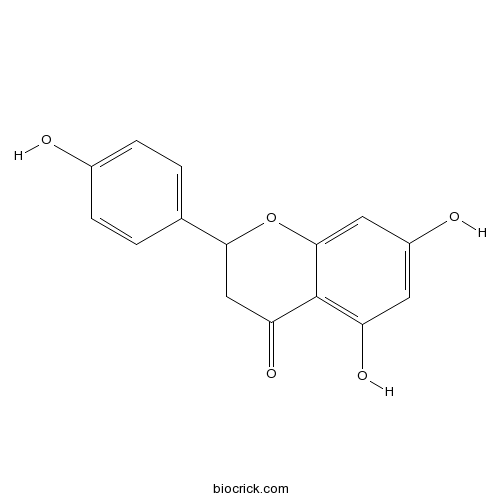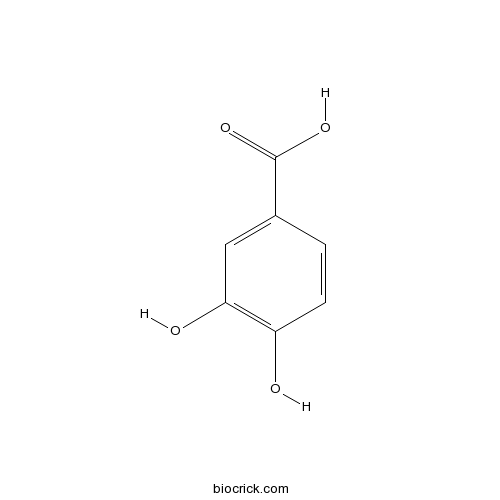Dracocephalum rupestre
Dracocephalum rupestre
1. The products in our compound library are selected from thousands of unique natural products; 2. It has the characteristics of diverse structure, diverse sources and wide coverage of activities; 3. Provide information on the activity of products from major journals, patents and research reports around the world, providing theoretical direction and research basis for further research and screening; 4. Free combination according to the type, source, target and disease of natural product; 5. The compound powder is placed in a covered tube and then discharged into a 10 x 10 cryostat; 6. Transport in ice pack or dry ice pack. Please store it at -20 °C as soon as possible after receiving the product, and use it as soon as possible after opening.
Natural products/compounds from Dracocephalum rupestre
- Cat.No. Product Name CAS Number COA
-
BCN5528
Betulin473-98-3
Instructions

-
BCN9061
(±)-Naringenin67604-48-2
Instructions

-
BCN4537
3,4-Dihydroxybenzoic acid99-50-3
Instructions

Neuroinflammatory response to experimental stroke is inhibited by eriodictyol.[Pubmed: 27353856]
Cerebral ischemia is a common disease and one of the most common causes of death and disability worldwide. The lack of glucose and oxygen in neuronal tissue leads to a series of inflammatory events, culminating in neuronal death. Eriodictyol is a flavonoid isolated from the Chinese herb Dracocephalum rupestre that has been proven to have anti-inflammatory properties.
Eriodictyol Attenuates β-Amyloid 25-35 Peptide-Induced Oxidative Cell Death in Primary Cultured Neurons by Activation of Nrf2.[Pubmed: 25994859]
Oxidative stress plays an important role in the pathogenesis of neurodegenerative diseases, including Alzheimer's disease (AD). Eriodictyol, a flavonoid isolated from the Chinese herb Dracocephalum rupestre, has long been established as an antioxidant. The present study was designed to investigate the effect of eriodictyol on β-amyloid 25-35 peptide (Aβ25-35)-induced oxidative cell death in primary neurons and to explore the role of the nuclear factor erythroid-2-related factor 2/antioxidant response element (Nrf2/ARE) pathway in this process. For this purpose, primary cultures of cortical neurons were exposed to 15 μM Aβ25-35 in the absence or presence of eriodictyol (20, 40 and 80 μM). The results revealed that Aβ25-35-induced cytotoxicity and apoptotic characteristics such as activation of JNK/p38 apoptotic signaling pathway were effectively attenuated by eriodictyol pretreatment. Eriodictyol treatment also resulted in an increase in Nrf2 protein levels and subsequent activation of ARE pathway genes in primary cultured neurons. The protective effects of eriodictyol were attenuated by RNA interference-mediated knockdown of Nrf2 expression. Taken together, these results clearly demonstrate that eriodictyol protects neurons against Aβ25-35-induced cell death partially through Nrf2/ARE signaling pathway, which further supports that eriodictyol might be a promising novel therapeutic agent for AD.
Eriodictyol protects against H(2)O(2)-induced neuron-like PC12 cell death through activation of Nrf2/ARE signaling pathway.[Pubmed: 22609376]
Eriodictyol, a flavonoid isolated from the Chinese herb Dracocephalum rupestre has long been established as an antioxidant. The present study was designed to explore the protective effects of eriodictyol against hydrogen peroxide (H(2)O(2))-induced neurotoxicity with cultured rat pheochromocytoma cells (PC12 cells) and the possible mechanisms involved. For this purpose, differentiated PC12 cells were cultured and exposed to 200 μM H(2)O(2) in the absence or presence of eriodictyol (20, 40 and 80 μM). In addition, the potential contribution of the Nrf2/ARE neuroprotective pathway in eriodictyol-mediated protection against H(2)O(2)-induced neurotoxicity was also investigated. The results showed that H(2)O(2)-induced cell death can be inhibited in the presence of eriodictyol as measured by assays for MTT and apoptosis. Further study revealed that eriodictyol induced the nuclear translocation of Nrf2, enhanced the expression of heme oxygenase (HO-1) and γ-glutamylcysteine synthetase (γ-GCS), and increased the levels of intracellular glutathione. Treatment of PC12 cells with Nrf2 small interference RNA abolished eriodictyol-induced HO-1 and γ-GCS expression and its protective effects. In conclusion, these results suggest that eriodictyol upregulates HO-1 and γ-GCS expression through the activation of Nrf2/ARE pathway and protects PC12 cells against H(2)O(2)-induced oxidative stress.
Eriodictyol-7-O-glucoside, a novel Nrf2 activator, confers protection against cisplatin-induced toxicity.[Pubmed: 22465804]
Eriodictyol-7-O-glucoside, a flavonoid isolated from Dracocephalum rupestre, is among the most potent free radical scavenger. In the present study, we identified eriodictyol-7-O-glucoside as a novel nuclear factor E2-related factor 2 (Nrf2) activator using a high-throughput cellular screening method. This compound activated Nrf2 signaling pathway and was able to stabilize Nrf2 by delaying Nrf2 degradation, resulting in accumulation of Nrf2 protein and activation of the Nrf2-dependent protective response. Recent studies have suggested that activation of Nrf2 pathway would confer protection against cisplatin-induced toxicity. The protective role of eriodictyol-7-O-glucoside in cisplatin-induced toxicity was investigated in a human renal mesangial cell line, HRMC. Cotreatment of HRMC cells with eriodictyol-7-O-glucoside significantly improved cell survival under cisplatin exposure. These findings demonstrated the feasibility of using natural compounds targeting Nrf2 as a therapeutic approach to subvert the side effects of cisplatin in normal cells.
Protective effect of naringenin-7-O-glucoside against oxidative stress induced by doxorubicin in H9c2 cardiomyocytes.[Pubmed: 22426099]
Doxorubicin (DOX) is one of the most effective chemotherapeutic agents, but cardiotoxicity limits its clinical use. Although the mechanisms are not entirely understood, reactive oxygen species (ROS) and cardiomyocyte apoptosis appear to be involved in DOX cardiotoxicity. Protection or alleviation of DOX cardiotoxicity can be achieved by administration of natural phenolic compounds via activating endogenous defense systems and antiapoptosis. Naringenin-7-O-glucoside (NARG), isolated from Dracocephalum rupestre Hance, could protect from cardiomyocyte apoptosis and induce endogenous antioxidant enzymes against DOX toxicity, but the effects on intracellular ROS generation and cell membrane stability were not demonstrated. In the present study, we investigated the effects of NARG on H9c2 cell morphology, viability, lactate dehydrogenase (LDH) and creatine kinase (CK) leakage, glutathine peroxidase (GSH-Px) activity, intracellular Ca2+ concentration, and ROS generation. Compared with DOX alone treatment group, the morphological injury of the cells in groups treated by DOX plus NARG was alleviated, cell viability was increased, the amount of released LDH and CK was significantly decreased, the activity of GSH-Px was increased, the content of intracellular Ca2+ and ROS generation was lowered remarkably. These results suggest that NARG could prevent cardiomyocytes from DOX-induced toxicity by their property of stabilizing the cell membrane and reducing ROS generation.
(1S*,2R*,4aS*,6aS*,6bR*,10S*,12aR*,14aS*)-10-Hydr-oxy-1,2,6a,6b,9,9,12a-hepta-methyl-perhydro-picene-4a,14a-carbolactone.[Pubmed: 21582484]
The title compound, C(30)H(48)O(3), was extracted from the plant Dracocephalum rupestre Hance. The mol-ecule contains five fused cyclo-hexane rings and one five-membered lactone ring. Inter-molecular O-H⋯O hydrogen bonds between the hydroxyl and carbonyl groups link the mol-ecules into chains along [010]. The absolute structure has not been determined.
Simultaneous determination of nine major active compounds in Dracocephalum rupestre by HPLC.[Pubmed: 18930620]
A new method was developed for the simultaneous determination of nine major constituents in Dracocephalum rupestre, including 5,7-dihydroxychromone (1), eriodictyol-7-O-beta-d-glucoside (2), luteolin-7-O-beta-d-glucoside (3), naringenin-7-O-beta-d-glucoside (4), apigenin-7-O-beta-d-glucoside (5), eriodictyol (6), luteolin (7), naringenin (8) and apigenin (9). The quantitative determination was conducted by reversed phase high-performance liquid chromatography with photodiode array detector (LC-PDA). Separation was performed on an Agilent Eclipse XDB-C(18) column (150 mm x 4.6 mm i.d., 5 microm) with gradient elution of acetonitrile and 0.5% aqueous acetic acid. The components were identified by retention time, ultraviolet (UV) spectra and quantified by LC-PDA at 260 nm. All calibration curves showed good linearity (r(2)>0.999) within test ranges. The reproducibility was evaluated by intra- and inter-day assays and R.S.D. values were less than 3.0%. The recoveries were between 95.15 and 104.45%. The limits of detection (LOD) ranged from 0.002 to 0.422 microg/ml and limits of quantification (LOQ) ranged from 0.005 to 1.208 microg/ml, respectively. The identity of the peaks was further confirmed by high-performance liquid chromatography with triple-quadrupole mass spectrometry system coupled with electrospray ionization (ESI) interface. The developed method was applied to the determination of nine constituents in 14 samples of D. rupestre collected at various harvesting times. Most compounds accumulated at much higher amounts in about June-July. The satisfactory results indicated that the developed method was readily utilized as a quality control method for D. rupestre.
Naringenin-7-O-glucoside protects against doxorubicin-induced toxicity in H9c2 cardiomyocytes by induction of endogenous antioxidant enzymes.[Pubmed: 18652870]
Doxorubicin, a widely used chemotherapeutic agent, can give rise to severe cardiotoxicity that limits its clinical use by generation of reactive oxygen species (ROS) and apoptosis. Protection or alleviation of doxorubicin cardiotoxicity can be achieved by administration of natural phenolic compounds via activating endogenous defense systems and antiapoptosis. Naringenin-7-O-glucoside (NARG), isolated from Dracocephalum rupestre Hance, has been demonstrated to protect against cardiomyocyte apoptosis. In the present study, we investigated the effects of NARG on endogenous antioxidant enzymes against doxorubicin toxicity and the potential role of extracellular signal-regulated kinase (ERK) in regulation of NARG-induced Nrf2-dependent gene expression in H9c2 cardiomyocytes. The mRNA expression of glutamate-cysteine ligase modifier subunit (GCLM) and glutamate-cysteine ligase catalytic subunit (GCLC) was upregulated by NARG as detected by RT-PCR. NARG (10, 20, and 40microM) pretreatment increased NAD (P) H: quinone oxidoreductase (NQO1), ERK, and Nrf2 protein levels in cardiomyocytes as detected by Western blotting. These results suggest that NARG could prevent cardiomyocytes from doxorubicin-induced toxicity by induction of endogenous antioxidant enzymes via phosphorylation of ERK1/2 and nuclear translocation of Nrf2.
Stereochemistry of flavonoidal alkaloids from Dracocephalum rupestre.[Pubmed: 18328514]
Phytochemical studies on the aerial parts of Dracocephalum rupestre led to the isolation of four groups of flavonoidal alkaloids, dracocephins A-D. They were elucidated as conjugates of flavanone with pyrrolidin-2-one on the basis of extensive spectroscopic analysis. The two stereogenic centers rendered each group of the dracocephins as two pairs of enantiomers simultaneously. All of the sixteen isomers were separated successfully by chiral HPLC and their stereochemical features were determined by their CD data and single-crystal X-ray diffraction analysis of one stereoisomer. The additive relation of the chiroptical contributions resulting from the two stereogenic centers was generalized. The CD contribution of the chiral carbon in the pyrrolidin-2-one ring was proposed by subtraction of their respective contributions.


